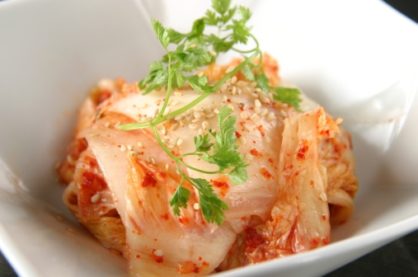While Americans swear by chicken soup’s remedial effects, Koreans believe kimchi health benefits cure everything from an upset stomach or a hangover to severe acute respiratory syndrome, or SARS. And the Korean staple has been infiltrating U.S. restaurants and health food markets for the past decade, earning praise and recognition for being low in calories, high in nutrients and a flavorful and versatile food to incorporate into meals. Certainly punched with a lot of health benefits.
Kim-what?
Kimchi, pronounced KIM-chee, is usually made with cabbage or daikon radishes, though Koreans sometimes use other vegetables — such as cucumbers and scallions — depending on the region and what’s in season. The vegetables are typically combined with garlic, ginger, chili pepper, salt, sugar and fish sauce, then fermented, giving the dish an acidic, tangy and spicy taste.
Potential kimchi health benefits
Koreans eat approximately 40 lbs. of kimchi per person each year, downing it for breakfast, lunch and dinner. Korean astronauts even eat a special kind of kimchi to prevent constipation, according to the Los Angeles Times.
Kimchi was originally fermented as a preservation technique for food during the winter, according to Livestrong. It turns out the fermentation has more benefits than just preservation: It also promotes the growth of healthy probiotic bacteria along the intestinal tract. In fact, kimchi is higher in lactobacilli — one of the probiotics that can help alleviate digestive problems, such as an upset stomach — than yogurt.
Kimchi is extremely low in calories, fat and sugar; high in fiber; and packed with vitamin A, vitamin C and iron. Some studies have reported a connection between kimchi consumption and weight loss, as well as a lowering of blood cholesterol levels. At least one study has suggested the food has the ability to cure birds infected with bird flu, and many believe it can prevent SARS, though not enough research has been conducted to confirm this.
Potential health risks
Consuming moderate amounts of kimchi will probably only do good things for your body and your health, but a 2006 study did find a link between eating extremely high amounts of kimchi and an increased risk of gastric cancer. It’s hypothesized that the correlation exists because the fermentation process raises the food’s salt content. The LA Times stated that the rate of gastric cancer is 10 times higher among Koreans and Japanese than Americans.
“It is not that kimchi is not a healthy food,” said Kim Heon, one of the researchers involved in the gastric cancer study from the department of preventive medicine at Chungbuk National University. “It is a healthy food, but in excessive quantities there are risk factors.”
How to eat it
You can add kimchi to countless dishes — and it tastes great by itself. It’s often used in soups or stews; eaten with eggs; mixed with fried rice; added as a topping to burgers, sausages or tacos; or eaten as an accompaniment to chicken, beef or seafood. We particularly love eating it Korean-barbecue style: using a piece of lettuce as a wrap and filling it with barbecued pork, kimchi and other toppings.
How to make it
Chow.com’s recipe for basic kimchi is simple, tasty and foolproof — it has step-by-step photos with the directions.
If you like kimchi, you might also enjoy do chua, the pickled daikon radishes and carrots used in Vietnamese sandwiches.
